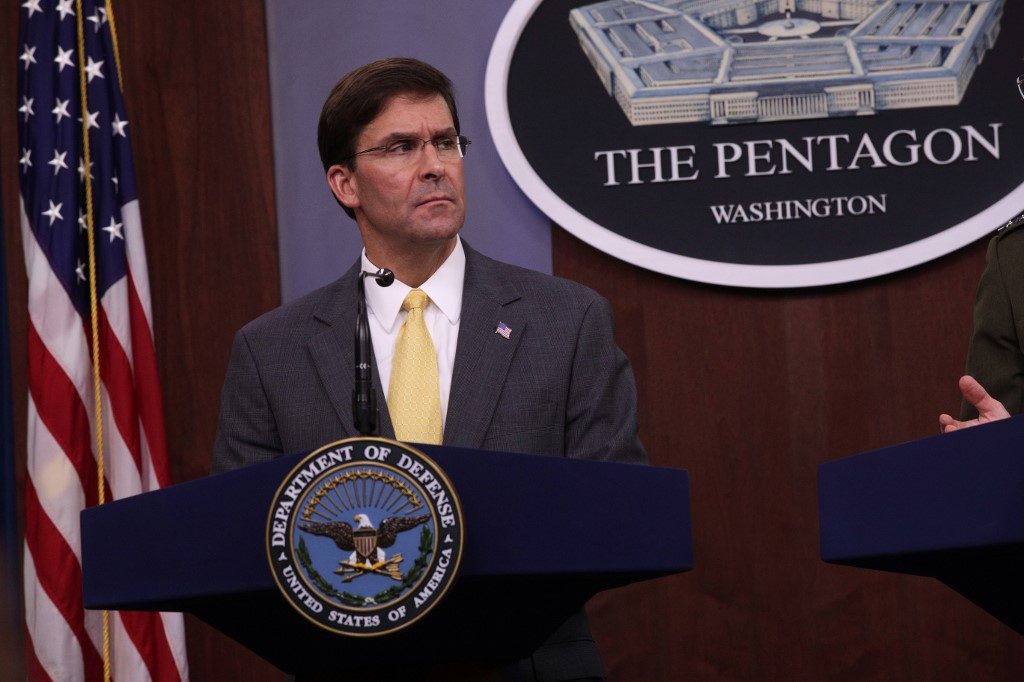SUMMARY
This is AI generated summarization, which may have errors. For context, always refer to the full article.

WASHINGTON DC, USA – US Defense Secretary Mark Esper said Wednesday, June 3, he was against using active duty troops to quell the protests for racial justice gripping the United States – breaking with President Donald Trump’s recent threat to deploy the military to restore order.
Tens of thousands of demonstrators had defied night-time curfews in several US cities going into a ninth day of unrest to voice anger over the death of George Floyd, an unarmed, handcuffed black man killed by a white police officer last week in Minnesota.
But the demonstrations were largely peaceful and while there were tense standoffs with law enforcement the protests did not feature the looting or clashes with police of previous days.
Trump has raised the possibility of invoking the rarely used Insurrection Act to deploy active duty soldiers against protesters but his Pentagon chief came out firmly against the move on Wednesday.
“I’ve always believed and continue to believe that the National Guard is best suited for performing domestic support to civil authorities in these situations in support of local law enforcement,” Esper said at a briefing.
“The option to use active duty forces in a law enforcement role should only be used as a matter of last resort and only in the most urgent and dire of situations,” he said. “We are not in one of those situations now.
“I do not support invoking the Insurrection Act.”
Trump denied media reports that he was rushed for his safety to the White House bunker while protests raged in the streets outside.
“It was a false report,” Trump told Fox News radio, before saying that he did go into the secure area for an “inspection” and only for a “tiny, little, short period of time.”
According to The New York Times, Secret Service bodyguards took Trump into the bunker on Friday night, May 29, and Fox News said he was also taken into the bunker on Sunday, May 31.
Reports of Trump taking shelter sparked a wave of online mockery, which is believed to have contributed to his decision on Monday, June 1, to make a controversial walk across Lafayette Park – just outside the White House grounds – to visit the partly damaged church of St. John’s.
Police violently dispersed mostly peaceful crowds of protesters to clear a path for Trump, and Esper on Wednesday sought to distance himself from his appearance at the photo opportunity.
“I do everything I can to stay apolitical,” he said. “My aim is to keep the department out of politics.”
The photo op was loudly condemned by religious leaders, the president’s political rivals, and onlookers around the country.
National Guard troops have been heavily involved in controlling the unrest in several US cities and Trump threatened on Wednesday to send them to New York City if the authorities there “don’t get their act together.”
“They’re violent people in many places,” Trump said, “a lot of bad people.”
He credited using the National Guard in Washington with making it “one of the safest places on Earth.”
“You have to have dominant force,” he said. “We need law and order.”
‘Did not die in vain’
Standoffs between police and demonstrators stretched into the night in cities from New York to Los Angeles over Floyd’s death.
A retired St Louis police captain was shot dead early Tuesday, June 2, outside a ransacked store, prompting Trump to tweet he was “viciously shot and killed by despicable looters.”
But there were fewer reports of the looting and violence that had soured street demonstrations in previous nights.
Tens of thousands gathered in Houston to pay a hometown tribute to Floyd, who grew up in the Texas city and is to be buried there next week.
“We want (Floyd’s family) to know that George did not die in vain,” Mayor Sylvester Turner told an estimated 60,000 people.
In New York, under its first curfew since World War II, hundreds refused to go home after the 8:00 pm cutoff, instead chanting slogans and peacefully walking the streets in Manhattan and Brooklyn.
Mayor Bill de Blasio, a day after several Manhattan luxury stores were looted, said it was a “very calm situation.”
Minnesota took one of the first concrete actions to address the grievances behind the uprising, which began after Floyd’s death on May 25 in the state’s largest city Minneapolis.
The state launched a civil rights investigation of the Minneapolis Police Department, looking at possible “systemic discriminatory practices” going back 10 years, Governor Tim Walz tweeted.
In Los Angeles, one of dozens of cities hit by unrest, police officers and Mayor Eric Garcetti dropped to their knees in a symbolic act of solidarity as they met marchers led by African-American Christian groups.
“A black face should not be a sentence to die, nor to be homeless, nor to be sick, nor to be underemployed, nor to be under-educated,” Garcetti said.
Joe Biden, Trump’s presumptive Democratic rival in the November election, denounced Monday’s crackdown on protesters in Lafayette Park as an abuse of power and promised, if elected, to tackle the “systemic racism” in the country.
“Donald Trump has turned this country into a battlefield driven by old resentments and fresh fears,” Biden said.
Hundreds of people also took to the streets of London on Wednesday to protest against Floyd’s death. Prime Minister Boris Johnson condemned the killing but dodged questions about whether he had raised the issue with key ally Trump. – Rappler.com
Add a comment
How does this make you feel?
There are no comments yet. Add your comment to start the conversation.